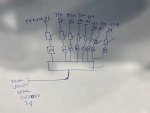hhsting
Senior Member
- Location
- Glen bunie, md, us
- Occupation
- Junior plan reviewer
I have 8 multi occupancy in single story commercial building. I have incoming service into trough outside wall of the building. The trough has eight service disconnects grouped for eight different occupants in the building. No main breaker.
Based on NEC 2014 Section 230.40 exception number 1: “...If the number of service disconnect locations for any given classification does not exceed six, the requirement of 230.2(E) shall apply at each location. If the number of service disconnect locations exceeds six for any given supply classification, all service disconnect locations for all supply characteristics, together with any branch circuit or feeder supply sources, if applicable, shall be clearly described with suitable graphics or text...” I am allowed to have more than six service disconnects so as long as I can label.
However, NEC 2014 section 230.71(A) says max allowed is six.
1. What is the difference between two and why their is discrepancy?
2. Does this mean I am not allowed more than six service discos or I am allowed so as long as I can label them 230.40 exception 1 for above case?
Sent from my iPhone using Tapatalk
Based on NEC 2014 Section 230.40 exception number 1: “...If the number of service disconnect locations for any given classification does not exceed six, the requirement of 230.2(E) shall apply at each location. If the number of service disconnect locations exceeds six for any given supply classification, all service disconnect locations for all supply characteristics, together with any branch circuit or feeder supply sources, if applicable, shall be clearly described with suitable graphics or text...” I am allowed to have more than six service disconnects so as long as I can label.
However, NEC 2014 section 230.71(A) says max allowed is six.
1. What is the difference between two and why their is discrepancy?
2. Does this mean I am not allowed more than six service discos or I am allowed so as long as I can label them 230.40 exception 1 for above case?
Sent from my iPhone using Tapatalk
Last edited:



